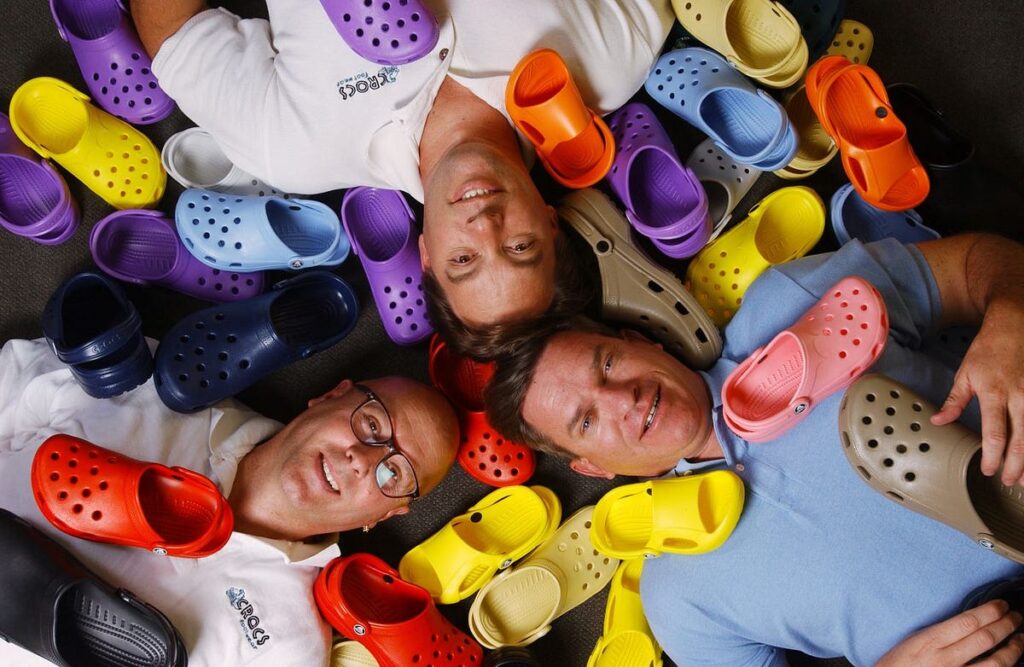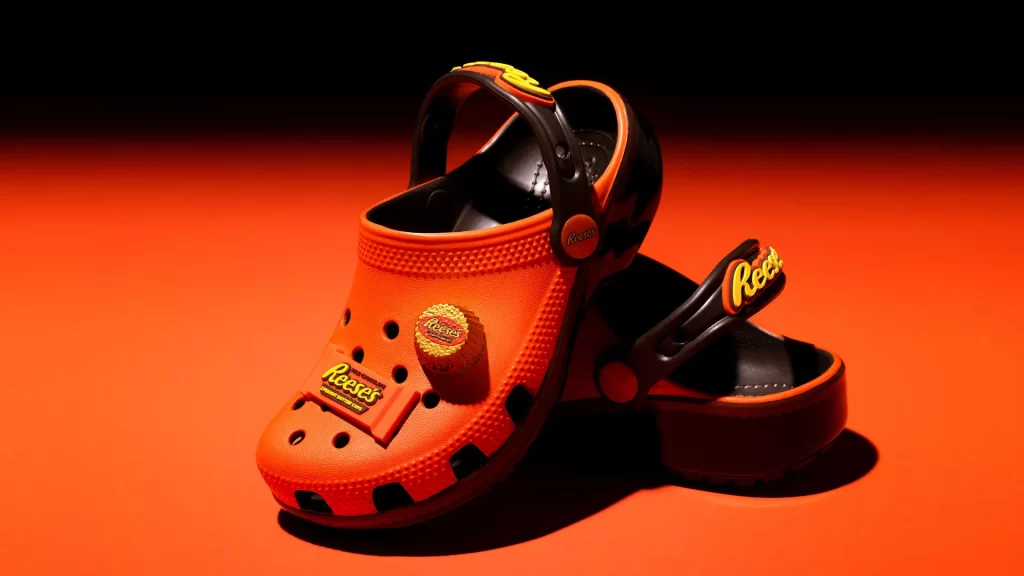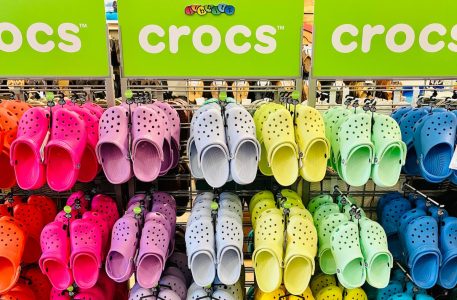Crocs, a type of footwear that has gained immense popularity over the years, have become a staple in many people’s wardrobes. First introduced in the early 2000s, Crocs have come a long way since their humble beginnings.
The idea for Crocs was born in the late 1990s when Scott Seamans, Lyndon Hanson, and George Boedecker, three friends who enjoyed boating and fishing together, realized there was a need for a shoe that could keep up with their active lifestyles. They wanted a shoe that was comfortable, waterproof, and easy to clean, but couldn’t find anything on the market that fit the bill.

Seamans, an avid sailor, had been using a pair of foam clogs he had picked up in Florida, but found them to be uncomfortable and lacking in support. He decided to create his own version, using a softer, more flexible material that would mold to the foot and provide better arch support.
Hanson, a chemical engineer, helped Seamans develop the proprietary material that would eventually become known as “Croslite.” It was a combination of resin and foam that was not only soft and pliable but also waterproof and resistant to bacteria and odors.
Boedecker, an entrepreneur with a background in sales and marketing, saw the potential for the shoes to appeal to a wider audience beyond just boat enthusiasts. He convinced Seamans and Hanson to join him in launching a company to produce and distribute the shoes.
The trio founded Crocs, Inc. in 2002 and began manufacturing their shoes in China. They debuted their line at the Fort Lauderdale International Boat Show, where they were met with immediate success. Orders poured in, and within six months, the company had sold over 100,000 pairs of shoes.
As demand grew, so did the variety of styles offered by Crocs. They added sandals, slides, and clogs with different straps and embellishments, as well as versions specifically designed for work environments, such as steel-toed and slip-resistant models.
One of the key factors in Crocs’ success was their ability to tap into the casual, laid-back style that was becoming increasingly popular in the early 2000s. People loved the fact that they could wear their Crocs anywhere, from the beach to the grocery store, without having to worry about dress codes or fashion faux pas.
The first iteration of Crocs was made from a soft, flexible plastic material called “Croslite.“ This unique material allowed the shoes to be lightweight, waterproof, and easy to clean. The holes on the upper portion of the shoe provided ventilation, keeping feet cool and dry even during intense physical activity. The distinctive look of Crocs, with their bright colors and large logo, quickly caught on with consumers.
Initially marketed towards boaters and beachgoers, Crocs soon became popular among various demographics, including healthcare professionals, construction workers, and children. The versatility of the shoe made it an ideal choice for anyone looking for comfort and functionality.
Over time, Crocs expanded its product line to include different styles and designs. From sandals to clogs, each new iteration maintained the signature comfort and durability of the original Classic Clog. The addition of Jibbitz, interchangeable charms that can be attached to the shoe, further increased the appeal of Crocs. Children and adults alike could now customize their shoes with their favorite characters, colors, or accessories.

Despite facing criticism from some fashion experts, Crocs continued to thrive. In 2014, the company went public, solidifying its place in the global market. Today, Crocs are sold in over 90 countries worldwide, with millions of pairs being produced annually.
In recent years, Crocs has also made efforts to address concerns about sustainability. The company has implemented measures to reduce waste, use eco-friendly materials, and promote recycling programs. As consumers become more environmentally conscious, Crocs is adapting to meet these changing needs while still maintaining its commitment to quality and comfort.
Throughout its history, Crocs has remained true to its core values of innovation, comfort, and fun. Whether you’re lounging by the pool, running errands, or working in a hospital, Crocs offers a wide range of styles suitable for any occasion. With its continued popularity and dedication to sustainability, it’s clear that Crocs will remain a beloved brand for years to come.
Success Factors of Crocs
There are several success factors that have contributed to the popularity and profitability of Crocs, a US-based footwear company that specializes in producing colorful, comfortable, and functional shoes. Here are some of the key success factors of Crocs:
1. Unique Design
Crocs carved their own path with a design as unconventional as it is comfortable. The iconic clog-like shape, punctuated with 13 playful holes, instantly screams Crocs. Made from their proprietary Croslite material, these shoes are light years away from your average footwear. Not only do they cradle your feet in pillowy comfort, but they’re also durable enough to withstand life’s messy adventures. This unique combo of playful practicality has propelled Crocs into a cultural phenomenon, proving that sometimes, breaking all the rules is the recipe for success.

2. Comfort
Crocs have built their empire on blissful comfort. Their secret weapon? A cushiony Croslite sole that molds to your feet like a memory foam dream, roomy designs that banish toe claustrophobia, and featherweight materials that make you forget you’re even wearing shoes. This ain’t just trendy talk – breathable fabrics keep feet cool and circulation happy, and some devotees swear by 12-hour Crocs marathons. Throw in backpack-clippable convenience and easy-wash practicality, and it’s no wonder Crocs have become the ultimate comfort champions, proving that sometimes, blissful steps pave the way to success.
3. Affordability
Fashion doesn’t have to drain your bank account, and Crocs know it. Forget breaking the bank for comfy feet – these playful clogs sit snugly in the mid-range sweet spot, making quality and comfort accessible to a wider audience. Their proprietary Croslite™ material delivers long-lasting durability and odor-resistance, while the minimal maintenance needs keep your wallet happy. Crocs are the champions of affordable comfort, proving that top-notch steps don’t require top-dollar prices.
4. Brand Recognition
From quirky garden shoes to fashion statement, Crocs have walked their way into global recognition. Those unmistakable clog shapes and infamous 13 holes are more than just footwear; they’re a cultural icon. Celebs embrace them, kids adore them, and even grandma can’t resist their comfy charms. This isn’t just about marketing clout; it’s about building a unique brand identity that’s as comfortable as it is eye-catching. Crocs aren’t afraid to be different, and that’s exactly what makes them unforgettable.
5. Sustainability
While Crocs haven’t always been sustainability stars, they’re making strides and earning eco-conscious kudos. Their signature Croslite material is surprisingly low-impact, made from a closed-cell resin that’s recyclable and odor-resistant. Plus, its durability means you’ll ditch disposable options, reducing waste. They’re also vegan-friendly, a big draw for environmentally conscious consumers. While there’s room for improvement, Crocs commitment to greening their game is earning them a growing legion of eco-conscious fans, proving that comfort and sustainability can walk hand-in-hand.
6. Collaborations and Partnerships
Crocs have mastered the art of the unexpected colab. From high-fashion houses like Balenciaga to pop stars like Post Malone, they’ve teamed up with the coolest names in the game, creating limited-edition collections that fly off the shelves. These partnerships aren’t just about slapping logos on shoes; they’re about infusing their iconic clogs with fresh energy and reaching new audiences. It’s a win-win, keeping Crocs relevant and exciting, while giving their collaborators a playful platform to express themselves. So, whether it’s streetwear collabs or designer drops, Crocs know that two (or ten) creative minds are better than one, proving that collaboration is the secret sauce to staying fresh and fabulous.

7. Strong Distribution Network
Crocs’ robust reach in over 90 countries, through a blend of company-owned stores, e-commerce platforms, and strategic partnerships with third-party retailers, has been a key driver in its success. Targeting its six core markets, including the U.S., Western Europe, China, India, Japan, and South Korea, Crocs strategically placed 373 stores in 2021, with a focus on the U.S. (162) and South Korea (89). This physical presence, bolstered by strong online channels, ensures convenient access for customers wherever they are.

Crocs’ continuous adaptation, as seen in the strategic adjustments like reducing its U.S. store count to 160 in 2022 while maintaining presence in key markets like South Korea (89) and China (33), showcases its commitment to optimizing its distribution network for long-term growth. In essence, Crocs’ omnichannel approach, coupled with intelligent market prioritization, has paved the way for its global success, making its distribution network a true footprint of triumph.
By focusing on these success factors, Crocs has built a loyal customer base and established itself as a leader in the footwear industry. The brand’s commitment to comfort, quality, sustainability, and innovation has enabled it to maintain a strong presence in the market and continue to attract new customers.
Also Read: Marketing Strategies and Marketing Mix of Crocs
To read more content like this, subscribe to our newsletter



